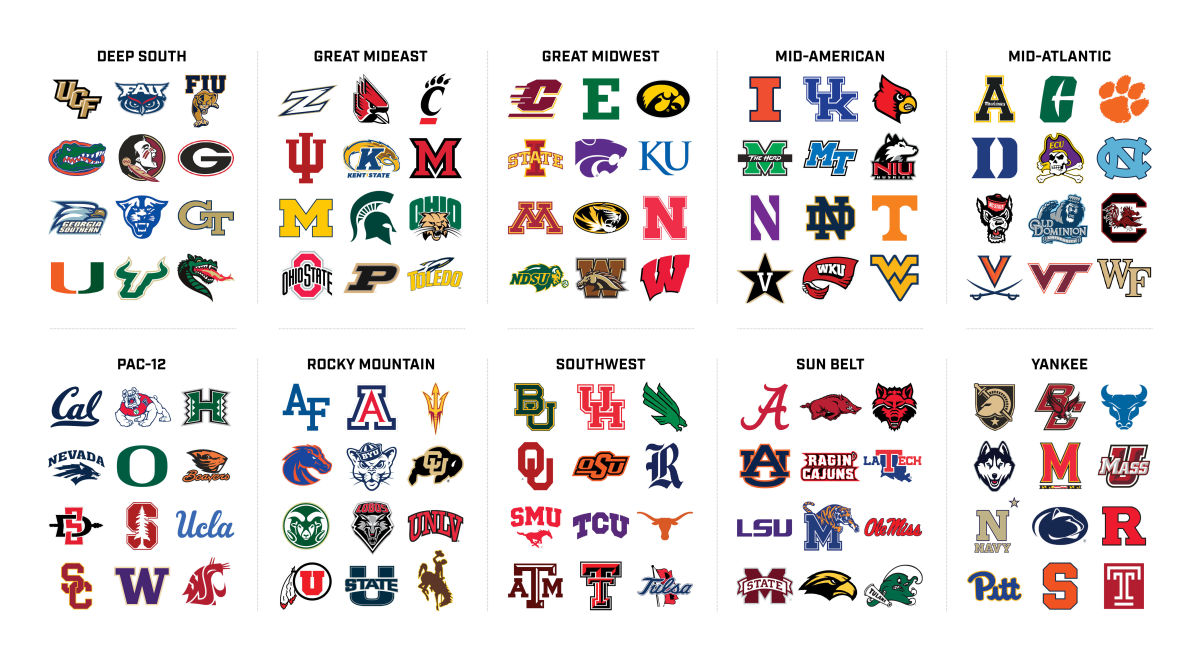What would a 12-team playoff look like with new alignment?
It's no secret that among Utah fans, Sports Illustrated's Pat Forde's new college football realignment wasn't among the most popular opinions when it comes to Utes football.
Forde took on the ever-difficult task of realigning the entire college football landscape, citing current geographical complications as his primary reason for doing so. Also, the current landscape isn't necessarily a competitive one for all schools — although doing so would be nearly impossible.
“If only this could be pitched to centralized leadership of college football that was interested in the good of the entire enterprise. But that doesn’t exist, and that’s another column for another day,” Forde wrote. “What college football would gain from this realignment: uniformity; conference championships that truly matter; increased access to a more lucrative playoff; a more level playing field for the little guys; renewed regional identity; cherished rivalries preserved, restored—and, in some cases, forced into permanent existence. The advantages are abundant.”
In Forde's new realignment, Utah actually takes a step back in competition from its current Pac-12 landscape when it joins the new Rocky Mountain conference — a 12-team conference featuring current Pac-12 foes Arizona, Arizona State, Colorado and the best of the current Group of 5 teams in Boise State.
- Air Force
- Arizona
- Arizona State
- Boise State
- BYU
- Colorado
- Colorado State
- New Mexico
- UNLV
- Utah
- Utah State
- Wyoming

Another part of Forde's realignment would be blowing up the current 4-team College Football Playoff. He proposes a 12-team playoff that features all 10 conference champions and two at-large bids. Since every team will play all 11 opponents in conference play, there is no longer a need for conference championship games.
The best and biggest playoff ever would start with a "Selection Sunday" on Nov. 29. The 12-team bracket would be revealed — featuring 10 automatic bids to the respective conference champions and two at-large teams chosen by a selection committee. All 12 teams would then be seeded by that same committee.
The result would be the first 4 teams getting a proverbial "bye" week, leaving teams 5-12 to square off in the first round. That means there would be four huge on-campus (high seeded team) playoff games to begin with on Dec. 4-5. The following weekend would then have the top four seeds hosting the second round of playoff games against the four winners in a bracket-style.
From there, the playoff reverts back to its to customary form: semifinals on New Year’s Day at bowl locations, and a national championship game in early January.
With that being said, Forde went ahead and did a simulated 2020 season within his new landscape and set up the 12-team playoff.
CONFERENCE CHAMPIONS
No. 1 Clemson, Mid-Atlantic Conference.
No. 2 Alabama, Sun Belt Conference.
No. 3 Ohio State, Great Mideast Conference.
No. 4 Georgia, Deep South Conference.
No. 5 Penn State, Yankee Conference.
No. 6 Oklahoma, Southwest Conference.
No. 7 USC, West Coast Conference.
No. 8 Florida, at-large selection from the Deep South Conference.
No. 9 Notre Dame, Mid-American Conference.
No. 10 Texas A&M, at-large selection from the Southwest Conference.
No. 11 Minnesota, Great Midwest Conference.
No. 12 Boise State, Rocky Mountain Conference.
In the end, Forde has Clemson taking down Georgia in one semifinal and Alabama beating Ohio State in the other, setting up a typical Clemson-Alabama showdown for the national title.

Some people might think this format results in too many games, but that's not the case. In the current CFP format, the two teams to meet in the national championship play 15 games — while in this format, the two teams vying for the title will play 16 games. It should also be pointed out that there are no conference championships, so each team that makes the new "playoff" will play a minimum of 13 games.
Forde also took into consideration the few colleges that are on semesters, and how they would navigate a finals week during the time of the playoffs.
"Playing into the second weekend of December and potentially getting in the way of semester finals? Yes, that’s a concern," Forde wrote. "But it only affects eight teams, and look what at least three conferences are preparing for this season: potentially moving back their conference championship games to that weekend in case early-season games are postponed or the season is delayed. If the Big 12, Big Ten and Pac-12 are willing to consider that, they’d be willing to consider this. (And, let’s not forget, Army and Navy usually play that weekend anyway."
Others might be questioning about the role that Cinderella teams may play like the early Boise State squads and most recently UCF. Initially these teams will be at a disadvantage, but once they can solidify their recruiting within the bigger conferences and get to 85 FBS scholarships, that playing field could level a lot quicker than others may think.
I fully get a lot of people, almost ALL Utah fans are against the realignment. But the thought of having a 12-team playoff is sensational, and anybody who doesn't support that must not be a fan of college football
Want to share opinions or ask questions? We want to hear them! Making a profile is free and it only takes ~1 minute to set up. Also, be sure to like us on social media for future coverage:
Twitter — @UtahUtes_SI and Ryan Kostecka at @Ryan_Kostecka
